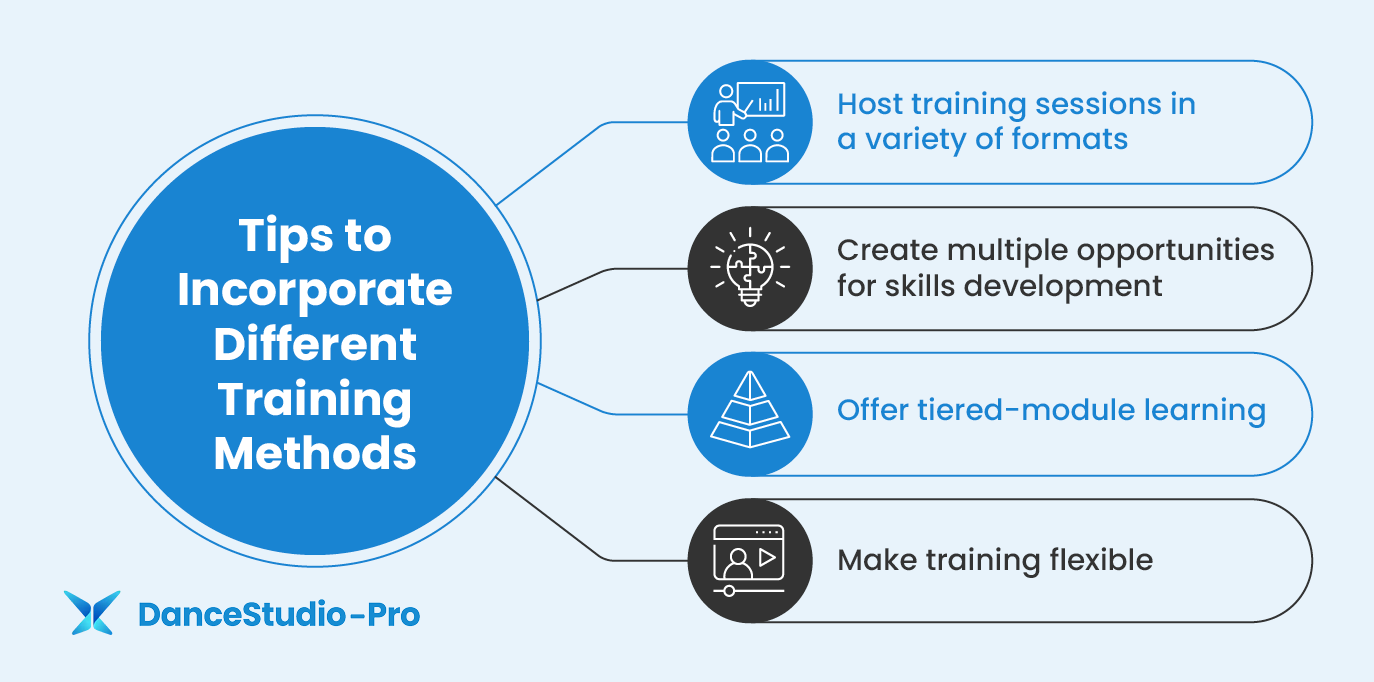
When employees arrive at your business, it’s more than likely that they don’t all have the same backgrounds. For example, if you’re expanding your marketing team, you’ll likely find that your Generation Z hires are well-versed in social media marketing, but less familiar with more traditional promotional strategies. On the other hand, some of your hires may have worked in marketing for years but aren’t as comfortable with new approaches.
As a result, you shouldn’t slap a one-size-fits-all approach to your employees’ training. Tailoring your training programs to each employee’s needs sets them up for success, leading to smoother operations across your small business.
Use these tips to train your employees so they can step into their roles with confidence:
- Survey your small business employees
- Incorporate a mix of training methods
- Develop a mentorship program
Whether you’re a dance studio owner, the chef at a small bakery, or the founder of a local clothing store, setting up a strong foundational training program can help you successfully onboard all of your employees and ensure they have the knowledge they need to excel. Let’s begin!
Survey your small business employees
To get your employees ready to tackle their roles or step into new responsibilities, you’ll first need to evaluate their competencies and identify areas where they may lack knowledge or skills. This can be done by sending out a digital survey as part of the onboarding experience.
However, rather than sending out the same survey to both a marketing assistant and a business manager, for example, it’s important to tailor your survey to specific teams so you can collect relevant insights about their skills.
For instance, let’s say you’re a dance professional who’s always led your dance studio marketing strategy with traditional offline media, like print ads and direct mail. However, you want to train your marketing team in digital marketing best practices so you can grow your reach online. To assess current competencies, you can ask the following marketing-specific questions in your survey:
- Please list any digital marketing tools, software, or platforms you are proficient in and have experience using.
- What specific digital marketing skills or areas of expertise do you believe you excel in, such as search engine optimization, email marketing, and/or social media advertising?
- What digital marketing certifications or training programs do you currently possess? Are there any additional certifications you plan to pursue to enhance your digital marketing skills?
- How comfortable are you with data analysis and using marketing analytics tools to measure the performance of online campaigns?
- Do you have any ideas or suggestions for improving our current digital marketing strategies or tactics?
You might find that you have team members who already possess some or all of the skills you’re looking for. By proactively assessing where your employees stand, you can create a holistic training plan that addresses knowledge and skill gaps and refreshes them on the skills they’ve already cultivated.
Incorporate a mix of training methods
Now that you have a baseline understanding of your employees’ knowledge level, it’s time to put these insights into action and get everyone on your team up to speed. Since your employees might be of different ages and backgrounds, it’s critical to use a variety of different training methods to meet everyone’s unique needs and learning styles.
Use these best practices as you roll out your training program for your employees:

- Host training sessions in a variety of different formats: Some of your employees may prefer hands-on training in an in-person environment, while others may learn best with interactive online modules. Offering both in-person and online training sessions and educational resources can help you meet these different preferences.
- Create several opportunities for skills development: In the same vein, provide a mixture of learning opportunities to keep the skills-development process fresh and appeal to all of your employees. For example, you could give your employees access to live and virtual workshops, learning manuals, videos, podcasts, conferences, and more. Check with your employees ahead of time to see what kind of educational resources they gravitate toward.
- Offer tiered-module learning: To accommodate varying skill levels, allow employees to choose whether they want to take a beginner, intermediate, or advanced module when offering virtual courses. If employees are starting at the beginner level, give them time to build up their training to reach the same advanced level as their peers.
- Make training flexible and accessible: Empowering your employees to choose the training methods that they most enjoy will lead to higher engagement rates and help them adopt their new responsibilities or roles more smoothly. Make the timing flexible, such as allowing employees to take virtual courses at any point before a certain deadline, to decrease pressure and grant your workers more autonomy.
If your business is concerned that offering employees more professional development opportunities may cause them to leave after their training is complete, don’t be! Double the Donation’s guide to employee engagement explains that retention rates are actually 34% higher among organizations that offer development programs. Your employees will appreciate the opportunity to grow and will be more likely to stick around and use these new skills to benefit your business!
Develop a mentorship program
Another great way to train your employees across age and skill levels is by tapping your employees themselves! With a mentorship program, you can pair new hires with veteran employees who can help one another fill their respective knowledge gaps. Let’s see what this might look like in action:
- Employee A is fresh out of college and new to working at your business. She knows all about SEO and social media marketing from past internships but isn’t familiar with how to execute a strong direct mail strategy.
- Employee B has worked at your small business for many years. He’s well-versed in print marketing but seldom works with digital marketing and content creation.
- Employee A can help Employee B learn all about digital marketing, while Employee B can help Employee A master offline strategies.
This method of peer-to-peer mentoring contributes to a strong sense of collaboration and community in your workplace, improving your employees’ work and pushing you further toward achieving your goals. Use the insights from your survey to pair employees together who can best help one another.
If you have one employee who is especially skilled in one area while other employees know nothing about this specific topic, you can even ask that knowledgeable employee to lead educational workshops for the entire team.
To streamline your mentorship program, you need a way for your employees to get into contact with one another easily. This is where a mobile messaging application can help, allowing employees to power off messages to each other anytime from anywhere quickly.
As you start your search for the right tool, consider leveraging a mobile messaging app specific to your business’s vertical. For example, DanceStudio-Pro explains that a dance studio could use a specialized app to streamline employee communications and make it easier for customers to register for classes and stay in touch with their studio. Do your research to find a multi-purpose app so you can get the most bang for your buck.
Wrapping Up
Your employees are all unique individuals with varying skills and knowledge levels. To maximize their efficiency, follow these simple tips so you can tailor your training program to their needs. Make sure to regularly check in with your employees and collect their feedback so you can increase the effectiveness of your training programs and fuel employee engagement.



